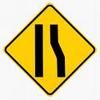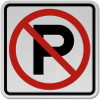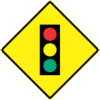Red Means Stop, But Not Always Stay
- Read more about Red Means Stop, But Not Always Stay
- 36 comments
- Log in to post comments
 Here's an interesting question from the DriveSmartBC inbox: There is a mid-block pedestrian controlled traffic light in our neighborhood. Drivers frequently stop and then proceed through it if no one is in the crosswalk. Is this legal?
Here's an interesting question from the DriveSmartBC inbox: There is a mid-block pedestrian controlled traffic light in our neighborhood. Drivers frequently stop and then proceed through it if no one is in the crosswalk. Is this legal?

 Question: Eastbound on Point Grey Road at Alma Street in Vancouver there are two bike lanes on the north side of the street that are allowed to cross Alma Street without stopping. On the diverter is a lane use sign for Eastbound traffic, "no straight ahead except for bicycles".
Question: Eastbound on Point Grey Road at Alma Street in Vancouver there are two bike lanes on the north side of the street that are allowed to cross Alma Street without stopping. On the diverter is a lane use sign for Eastbound traffic, "no straight ahead except for bicycles".
 Here is another video from
Here is another video from  One correspondent observed that "It seems that drivers in BC generally have a big problem when it comes to merging. In this case let's say from two lanes to one. In the normal course of events merging shouldn't be any hassle at all - take turns, one from the left then one from the right - it all moves along nicely, and has a minimal effect on holding up traffic. Not in BC! Here it appears to be everyone for him / herself.
One correspondent observed that "It seems that drivers in BC generally have a big problem when it comes to merging. In this case let's say from two lanes to one. In the normal course of events merging shouldn't be any hassle at all - take turns, one from the left then one from the right - it all moves along nicely, and has a minimal effect on holding up traffic. Not in BC! Here it appears to be everyone for him / herself. Parking, stopping or standing, what's the difference and why is it important to you as a driver? Recognizing these road signs and knowing what is allowed and what isn't with regard to these three situations can mean the difference between your convenience and being ticketed and towed for ignoring or mistaking them.
Parking, stopping or standing, what's the difference and why is it important to you as a driver? Recognizing these road signs and knowing what is allowed and what isn't with regard to these three situations can mean the difference between your convenience and being ticketed and towed for ignoring or mistaking them. QUESTION: I was involved in a collision at West 59th Avenue and Oak Street in Vancouver. Would you would be able to direct me to the appropriate source to retrieve data from that specific traffic light? If possible, the information I am seeking pertains to whether or not that pedestrian controlled traffic signal was red, yellow, or green light on a particular date and time.
QUESTION: I was involved in a collision at West 59th Avenue and Oak Street in Vancouver. Would you would be able to direct me to the appropriate source to retrieve data from that specific traffic light? If possible, the information I am seeking pertains to whether or not that pedestrian controlled traffic signal was red, yellow, or green light on a particular date and time. The Institute of Transportation Engineers is a North American body that develops technical resources including standards and recommended practices used in our road designs. One of their newest resources aims to assist transportation professionals in the planning, design, and operation of bicycle traffic signals. It is available to the public as well, so if you are curious about what could be done to develop the cycling route you use, the site offers plenty of information.
The Institute of Transportation Engineers is a North American body that develops technical resources including standards and recommended practices used in our road designs. One of their newest resources aims to assist transportation professionals in the planning, design, and operation of bicycle traffic signals. It is available to the public as well, so if you are curious about what could be done to develop the cycling route you use, the site offers plenty of information. A motorist will encounter three types of flashing traffic signals, red, yellow and green.
A motorist will encounter three types of flashing traffic signals, red, yellow and green.  QUESTION: Eastbound on Point Grey at Alma there are two bike lanes on the north side of the street that are allowed to cross Alma without stopping. Cars eastbound on Point Grey must turn either right or left, and there is a curb/diverter on the far side to prevent them going straight through.
QUESTION: Eastbound on Point Grey at Alma there are two bike lanes on the north side of the street that are allowed to cross Alma without stopping. Cars eastbound on Point Grey must turn either right or left, and there is a curb/diverter on the far side to prevent them going straight through.